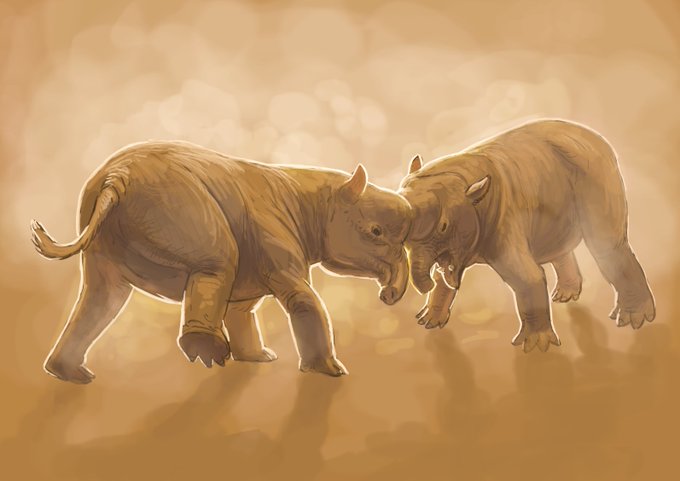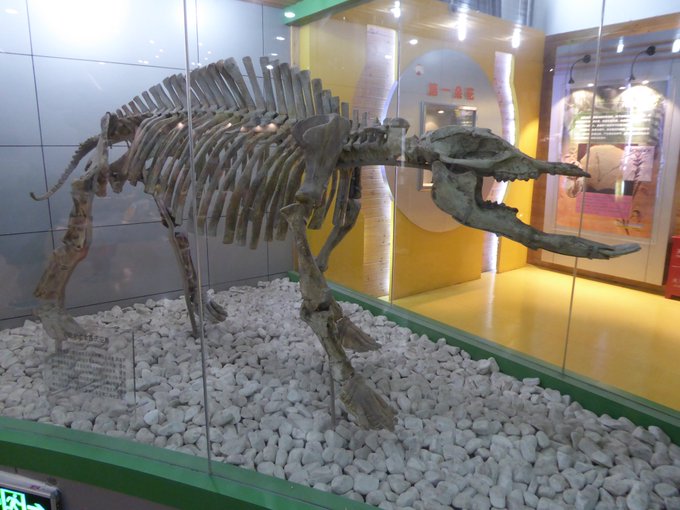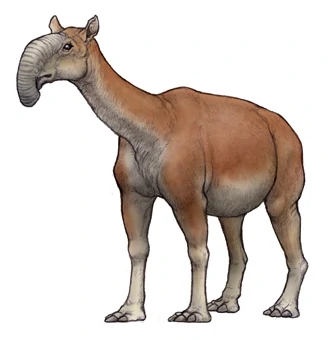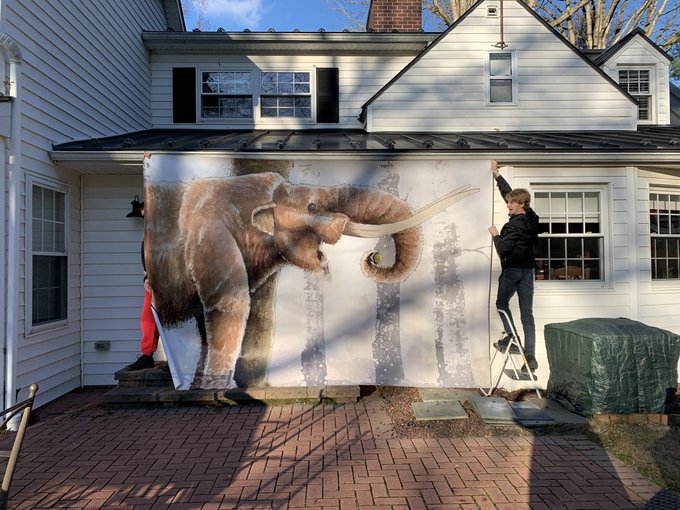PROBOSCIDEAのTwitterイラスト検索結果。 77 件中 2ページ目
Something nicer for a change: Moeritherium and Phiomia, two very early elephant relatives. @VilleSinkkonen had a proboscidean phase and insisted I draw some too. I just got myself together for long enough to finish them.
Today we had a very special #paleostream! We looked into the anatomy, ecology and phylogeny of #Numidotherium, one of the earliest and WEIRDEST proboscideans ever! It's a roughly tapir sized animal from the Eocene of Algeria, from the El Kohol formation. (1/many)
Reitmeyer et al (2021) provide a unique look at the women working on palaeoart at the AMNH in the early C20th. Margret Joy Flinsch Buba reconstructed Proboscidea and went on to sculpt Pope Paul VI. And here’s Elisabeth Rungius Fulda’s (what a name) beautiful 1923 Baluchitherium.
Our Mastodon shares their environment with black bears and a goose, two local animals left in the shadow of the now extinct proboscidean. One major aspect of our outreach is conveying just how many animals are more than we often think of them as.
The woolly mammoth (Mammuthus primigenius), because I want proboscideans living where I am.
Art of a mammoth in their winter coat by @paleobyliam. Range map via Wikimedia Commons. https://t.co/yMvZccurIJ
THE CHRISTENING OF SISTER MOUSE. An exploration on kinds of headgear for the Greenbrier mice, prominently featuring proboscidea spicata. A mouse's cowl is an essential part of their identity, and made from an object foraged from their local environment.
Phiomia was an early member of the Proboscidea; distantly related to true Elephants. Remains are known from the Faiyum region of Egypt; from the Late Eocene to the Early Oligocene.
Started working on a little Phosphatherium today. Might develop the sketch later this week after I wrap up a few projects.
#proboscidea #WIP #sketch #paleoart #MammalMonday
It's #FossilFriday, so I thought you might enjoy these Platybelodons 😃A proboscidean (group that incl. elephants🐘) that lived ~15-5 mya in Eurasia, Africa & N. America. These are in the Beijing Museum of Natural History. #Palaeoart by Nikolai Litvinenko. #mammals #fossils
Gomphotherium is an extinct genus of proboscidean that lived in the early Miocene of North America.
@matthewcobb @morethanadodo There are quite a few other animals with trunks (trunks = extended upper lip + snoot). And not all elephants (proboscideans) had trunks, the earliest didn't. But certainly elephants really went to town with their sniffers! 🐘 (pics: Wikipedia/dinopedia)
@TetZoo Within the speculative branch of African cryptozoological theorizing, the active rejection of the “dinosaur” origins for Mokele-Mbembe and ndgoko na maiji (Teke: "water elephant") sightings have opened the window to intriguing talk of extinct species in the order Proboscidea.
Name: Elderfrost Gammoth (銀嶺ガムート)
Title: World's Greatest Peak (世界最強峰)
Length: 2788.69cm
Order: Proboscidea
Suborder: Scalp
Family: Gammoth
Habitats: Arctic Ridge, Frozen Seaway, Polar Field
Photo attempt number one: I curse my house for its terrible lighting.
I’m looking to find a home/buyer for my 9ishx12ish vinyl #mastodon poster. As a part of my thesis, it never saw the light of day until now. (Can also print new copies)
#paleoart #proboscidean
Cuvieronius was a strange, elephant-like animal related possibly to the mastodons, and probably lived in a variety of environments from chilly highlands, to warm jungles. It was well-known for its rather spiraled tusks unlike any other known proboscidean. Twisted!
DIA 6 - #PROBOSCIDEA
Para la palabra de hoy tenemos a #Stegotetrabelodon syrticus, concretamente una hembra y su cria.
#PaleoInktober2020 #PaleoInktober #InktoberDay6 #Inktober2020 #PaleoArt #Paleontology
Sicilian dwarf elephant (Palaeoloxodon falconeri), a proboscidean from Pleistocene Sicily that reached 1.3 meters in height. #paleoart #elephants
Here are my top 4 extinct proboscideans, challenge by @Gamarraptor
- Stegoterabelodon syrticus
- Deinotherium bozasi
- Palaeoloxodon namadicus
- Gomphotherium angustidens
(love em all despite the rankings)






















































